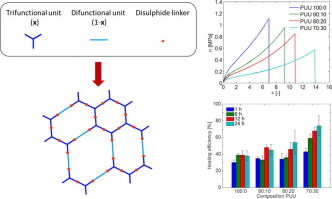当前位置:
X-MOL 学术
›
Eur. Polym. J.
›
论文详情
Our official English website, www.x-mol.net, welcomes your feedback! (Note: you will need to create a separate account there.)
Effect of the polymer structure on the viscoelastic and interfacial healing behaviour of poly(urea-urethane) networks containing aromatic disulphides
European Polymer Journal ( IF 6 ) Pub Date : 2017-12-01 , DOI: 10.1016/j.eurpolymj.2017.10.007 A.M. Grande , R. Martin , I. Odriozola , S. van der Zwaag , S.J. Garcia
European Polymer Journal ( IF 6 ) Pub Date : 2017-12-01 , DOI: 10.1016/j.eurpolymj.2017.10.007 A.M. Grande , R. Martin , I. Odriozola , S. van der Zwaag , S.J. Garcia

|
The macroscopic interfacial healing behaviour in a series of urea-urethane networks as function of the hydrogen bonds and disulphides content is presented. The polymers were prepared with different crosslinking densities but with the same amount of dynamic covalent bonds (disulphide linkages). Tensile and fracture measurements were adopted to evaluate the degree of recovery of the mechanical properties after damage. Healing kinetics and healing efficiencies were quantitatively determined as a function of network composition, healing temperature and contact time. Finally, the recovery of mechanical properties was correlated with the viscoelastic response of the networks through rheological measurements and time-temperature superposition principle (TTS). The application of the TTS approach on both fracture healing and DMTA and subsequent mathematical descriptive model led to a better understanding of the influence of polymer architecture and that of the amount of reversible groups on the healing process.
中文翻译:

聚合物结构对含有芳族二硫化物的聚(脲-氨基甲酸酯)网络的粘弹性和界面愈合行为的影响
呈现了作为氢键和二硫化物含量的函数的一系列脲-氨基甲酸酯网络中的宏观界面愈合行为。制备的聚合物具有不同的交联密度,但具有相同数量的动态共价键(二硫键)。采用拉伸和断裂测量来评估损伤后机械性能的恢复程度。愈合动力学和愈合效率被定量确定为网络组成、愈合温度和接触时间的函数。最后,通过流变测量和时间-温度叠加原理(TTS),机械性能的恢复与网络的粘弹性响应相关。
更新日期:2017-12-01
中文翻译:

聚合物结构对含有芳族二硫化物的聚(脲-氨基甲酸酯)网络的粘弹性和界面愈合行为的影响
呈现了作为氢键和二硫化物含量的函数的一系列脲-氨基甲酸酯网络中的宏观界面愈合行为。制备的聚合物具有不同的交联密度,但具有相同数量的动态共价键(二硫键)。采用拉伸和断裂测量来评估损伤后机械性能的恢复程度。愈合动力学和愈合效率被定量确定为网络组成、愈合温度和接触时间的函数。最后,通过流变测量和时间-温度叠加原理(TTS),机械性能的恢复与网络的粘弹性响应相关。



























 京公网安备 11010802027423号
京公网安备 11010802027423号